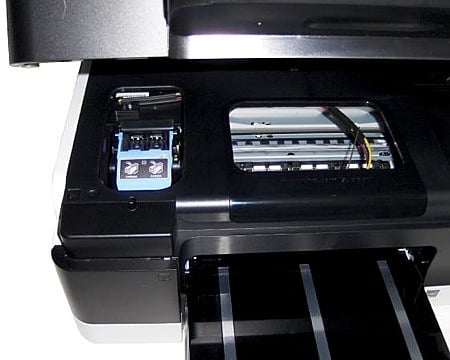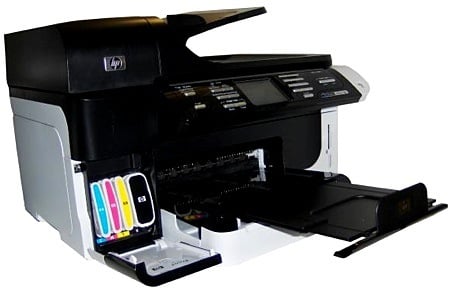This article is more than 1 year old
HP OfficeJet Pro 8500 Wireless
Colour laser killer?
To set up wirelessly, you scan for networks from the OfficeJet Pro and enter whatever encryption key is necessary. Then install the network driver on a PC or Mac, which spots the machine on the network and completes the connection. There are drivers for versions of Windows from 2000 on and for Mac OS X 4.11 and above. There are no HP Linux or Unix drivers.

Each drop-in head handles two colours
HP includes its own software bundle with the machine, which includes optical character recognition (OCR) for use with the scanner, as well as basic photo editing through Photosmart Essential.
Setting the device up physically is also fairly easy. Two removable print heads, each servicing two ink colours, have to be slotted into the head carrier and the four ink cartridges plug in at the front of the machine, behind a fold-down cover. There’s a prolonged charge cycle, which needs to be run through on each cartridge change, and the device is then ready to print.
HP quotes the speed of the OfficeJet Pro 8500 as 35ppm and 34ppm respectively for black and colour in draft mode, and 15ppm and 11ppm in "laser comparable" mode. We printed in normal quality and completed a five-page black-text document in 29 seconds, a speed of 10.3ppm. This rose to 12.8ppm for a 20-page job, so pretty close to the quoted speed - and pretty fast for an inkjet.
A five-page text and colour graphics job took 52s (5.8ppm) so not as close to the specs, but still quick. Print duplex, though, and print speeds plummet. A 20-side print took 6m 08s, or 3.3spm. This is largely due to waiting for the first side of each page to dry before printing the second and is common to most duplex inkjets, though it’s exacerbated here by the slower drying pigment inks.

The ink cartridges are very easy to replace
Since HP's Vivera inks are pigment-based, they are much more resistant to water and light fade than more commonplace dye-based inks, and while prints are not as clean as they are from a typical dry toner printers, the colour gamut is a lot wider, meaning photo prints are a good deal more natural.
